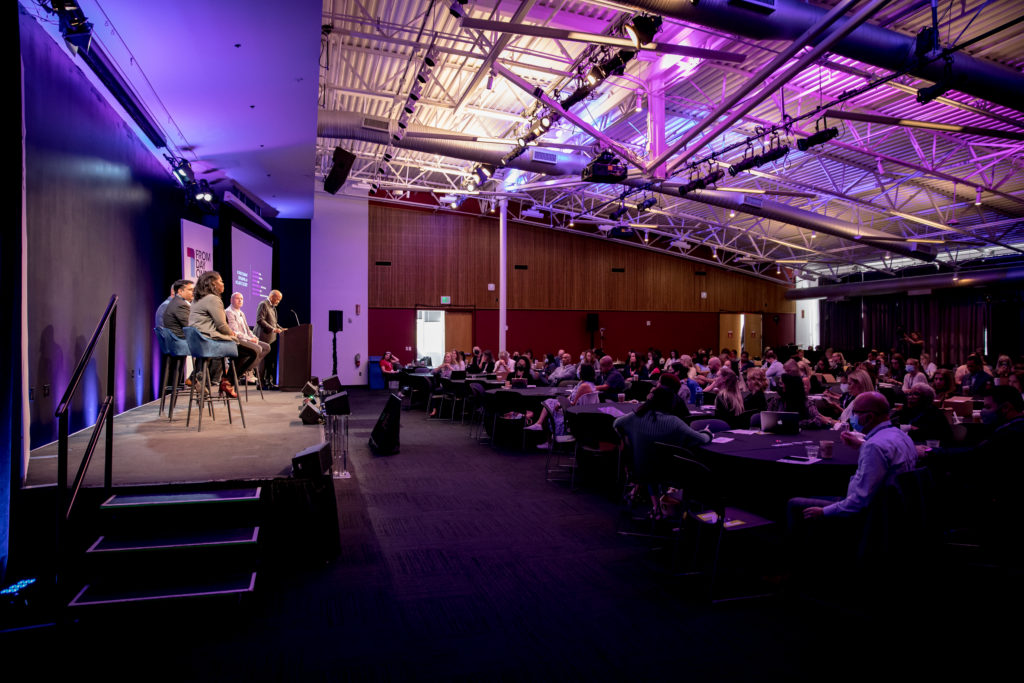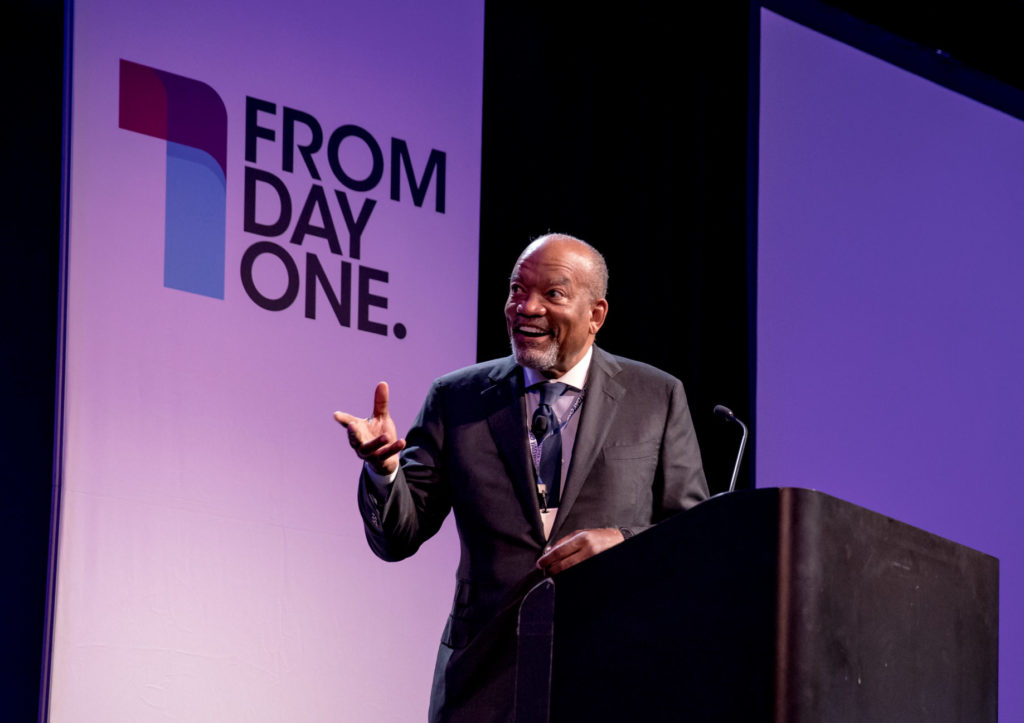How to Make Inclusion Work From the Bottom Up


While the conversation about diversity, equity, and inclusion (DEI) has evolved at a swift pace in the last two years, it helps to have the perspective of age. Charles Moses, DBA, remembered having similar discussions about workplace culture 40 years ago. “Things were simpler then,” said the veteran journalist and current dean of Eberhardt School of Business at the University of the Pacific. Moderating a panel entitled, “Is Your Company Developing an Inclusive Culture?” at From Day One’s Silicon Valley conference in June, Moses said he had good news and bad news to offer.
“The good news is that we have better language to understand what people are experiencing when they interact with corporations and other entities,” he said. And then the bad news: “I’m not sure we're doing a better job.”
A survey at Stanford University last year underscored that observation, with faculty and students reporting the harmful behaviors of discrimination and the negative effects of experiencing exclusion. The effects of the lack of inclusion, the respondents said, ranged from difficulty concentrating, eating, or sleeping, to ultimately leaving school. Informed by its findings, the institution is incorporating focus groups and other discussions to determine the next steps, said panelist Rosalind Conerly, EdD, associate dean and director of Stanford’s Centers for Equity, Community and Leadership.
“A lot of organizations need to examine what they’re doing wrong and really be brave and transparent about that,” Conerly said. “To me [inclusion] means it’s action-oriented. I think about what we’re doing in our organizations to really create these opportunities for equitable access to resources for folks that may feel marginalized or ‘othered.’ This could mean reforming or creating new policies or practices.”
As the conversation progressed, Moses encouraged speakers to focus on the behaviors that elicit inclusivity in the workplace. Among their insights:
Putting Feedback Into Action
Transparency encourages inclusiveness, several speakers asserted. As noted by Chris Young, head of sales at HiBob, the HR platform, openness at all levels requires trust and constant feedback. Often, the feedback can lead to greater buy-in and can help formulate new policies. “Our hybrid-remote plan [was] essentially written by all of our employees—which, across 16 countries, took a little bit of feedback to get done. But once we got that feedback, we were able to put it in place and set our expectations around it.”

A key component of receiving feedback is not just listening, but also taking action. “Your leadership needs to show that they are open to hearing and listening and responding to you in some way,” said Kara Silverstein, director of integrity and senior director of people operations at Google. “Because otherwise your employee just feels lost and they feel that their voice isn’t valued, their perspective isn’t important. And then you really are going to erode this inclusive cultural path.”
Incorporating employee resource groups (ERGs) is another way of utilizing feedback and employee engagement. “It’s really focused on empowering and retention,” said Stanford’s Conerly. “We’re seeing ours as a formal and informal mentoring tool as well. Folks are able to connect across industries, across projects that they’re working on, but it’s also an opportunity for our employees to really tap into their zone of genius.” Employees can use ERGs to engage with something they’re interested in that may not be a part of their specific roles or job duties.
There are benefits for the organization as well. Before Stanford launched its campus-wide DEI survey, it asked Conerly’s group to comment on the questions. “So thinking about your DEI strategy and your roadmaps, a lot of folks are starting to use these ERG groups for implementation of their DEI initiative. That isa big way that you can continue to utilize your groups.”
Engaging Emotional Intelligence
To foster an inclusive environment, organizations must activate emotional intelligence (EQ). It’s vital that leaders show empathy, while “respecting and valuing our differences,” said Prasun Maharatna, VP of HR at Zensar Technologies, a digital-transformation company, who added the importance of “widening the listening capabilities of the organization.” Doug Dennerline, CEO and executive chairman of Betterworks, a performance-management platform, agreed. “Empathy’s the key thing, and it starts at the top.” His company goes as far as regularly asking its staff, “Are we being empathetic enough?”
“It goes beyond just making people feel like they belong,” said Dennerline. “Seventy-eight percent of people in an organization of greater than a thousand people don’t really understand how their work helps the company achieve the goals that it’s trying to achieve. It’s inclusive when you know that what you’re doing every day is actually helping somebody feel good about helping achieve something. I also think without inclusion, you don’t really get to diversity. One follows the other.”

Many panelists mentioned the necessity of increased training for leaders, and rethinking top-down hierarchical structures to a bottom-up strategy. “We’ve had a lot of great ideas and innovation come doing that flip,” said HiBob’s Young. “Whether it’s creating culture committees that the teams have been asking for, whether it’s switching our KPIs to KBAs (Keep Being Awesome), whether it’s our high-growth performance management—where we used to think about the number and the rating and now it’s coming from the people up—and it’s the skills they think they need help with and how we can help get them there.”
Playground Rules
Inclusivity is “not the work of a few,” said Silverstein, “but it’s the work of all.” And everyone must see themselves in the solution.
When events outside of the workplace have a negative impact, people can feel like their identities are being challenged or that they’re unsafe in some way in their communities. “You need to acknowledge what folks are going through,” said Silverstein. “What we found is that it’s really important to set boundaries. Silverstein wrote Google’s Community Guidelines, which were adopted a few years ago. “When people are interacting online, there’s a thin line between a work conversation and a Reddit thread. We’re not barring any particular conversations, but we’re setting guidelines on the way you have those conversations,” she said.
“It's not that there are taboo topics per se, but it’s about how you treat one another with respect,” Silverstein continued. “You are each responsible for creating a community of inclusion here. You are each responsible for making sure that your coworkers feel like they belong. And so you need to consider the words you are saying, and whether you are doing that. Some of the rules I refer to feel like they were ones that were introduced to my kids in kindergarten—‘Treat others how you would want to be treated,’ and things like that. But it works with adults as well. If you do not show where the lines are, then you can't expect people to follow them.”
Samantha Campos is a freelance journalist who’s worked for regional publications in Hawaii and California, with forays into medical cannabis and food justice nonprofits. She currently resides in Oakland, Calif.
The From Day One Newsletter is a monthly roundup of articles, features, and editorials on innovative ways for companies to forge stronger relationships with their employees, customers, and communities.